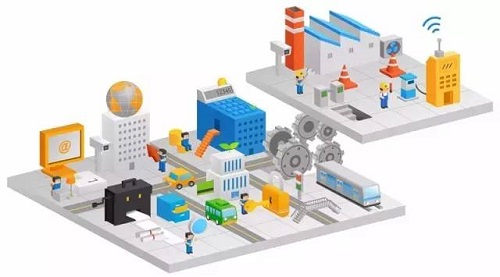The Industrial Internet of Things (IIOT) offers the potential to transform manufacturing, both internally and externally—increasing equipment utilization, improving workflows, and optimizing supply chains. By understanding how Industrial IoT can deliver better business outcomes, manufacturers and other players in the value chain can reduce costs, improve product and service quality, shorten time to market, increase flexibility, and better engage with customers and suppliers interactions, all of which lead to significant competitive advantages in today’s digital economy.


Industrial IoT inside the factory
One of the most important ways in which Industrial IoT can improve business outcomes is by enabling manufacturers to protect, analyze and use data from factory equipment to create “smart factories” that operate efficiently. Specifically, manufacturers can integrate IoT devices into Industrial IoT solutions and use mobile and other wireless technologies to collect and analyze data from the devices, which is then transmitted to manufacturing execution and quality management systems. And combined with other factory data, it provides value for optimizing the performance of all manufacturing activities in the factory.
- Reduce operational risk by identifying equipment problems so they can be corrected before negative impacts occur.
- Identify workflow issues and other challenges that may cause production slowdowns or quality issues.
Industrial equipment suppliers can also use the Industrial IoT to offer new services to manufacturers to increase the value of their equipment. For example, connectivity is easier thanks to wireless technology, and equipment vendors can integrate sensors into equipment, which can provide rich operational insights by remotely monitoring equipment around the clock. This monitoring capability helps suppliers troubleshoot issues and enables them to provide predictive maintenance services.
- Reduce unplanned downtime
- Eliminate premature or unnecessary maintenance
- Improve overall equipment efficiency
- Simplify maintenance planning and parts ordering
- Improve the energy efficiency of your equipment
Additionally, IIoT enables industrial equipment suppliers to offer new value-added services to manufacturers, such as automated alerts on machine status and automated delivery of equipment consumable supplies. Some suppliers may even be able to pivot from selling equipment to selling services by relying on field operational data provided by Industrial IoT applications. These “device-as-a-service” business models enable manufacturing customers to avoid large upfront capital investments and only pay for the use of the equipment, which better aligns the cost with the value of the equipment. These business models also enable equipment suppliers to tailor services to the manufacturer’s specific needs and use data analytics to optimize long-term equipment use, thereby increasing equipment efficiency and delivering greater savings to customers.
Industrial IoT outside the factory
In addition to transforming the factory floor, Industrial IoT enables manufacturers to move materials and products in and out of factories more efficiently. A recent study estimated that $1.9 trillion in economic value could be created using IoT devices and asset tracking solutions in the global supply chain/logistics sector alone.
Without the required parts and spare parts, the factory cannot produce. Tracking sensors (located on parts, pallets or shipping containers) combined with mobile connectivity and cloud-based tracking services enable suppliers to provide manufacturers with the location of needed supplies.
- Streamline operations with just-in-time delivery
- Anticipate and respond to material shortages
- Create greater cash liquidity through leaner inventory
- Optimize worker productivity
- Better manage customer expectations
- Eliminates frequent searches for supplies somewhere in the factory
Industrial IoT solutions that combine sensors, mobile connectivity, and cloud-based tracking services can also enable third-party logistics companies to optimize the distribution of manufacturers’ products. By connecting their fleets to a central visibility platform, third-party logistics companies can optimize the transportation of products from factories to customers and distributors.
Product location/status information can also help third-party logistics companies speed up deliveries by revealing bottlenecks and other potential sources of delays. Third-party logistics companies can also respond quickly to changing traffic and weather conditions. Knowing the exact location of a product can even help third-party logistics companies prevent or respond to theft.
